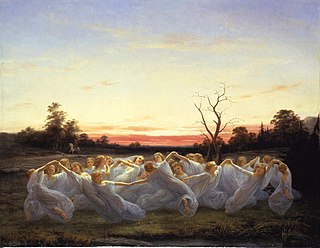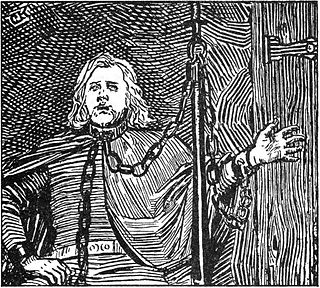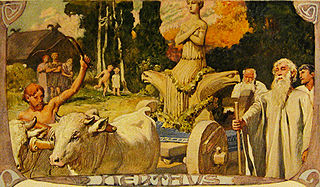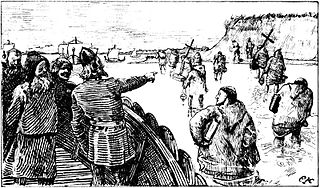Related Research Articles

Baldr is a god in Germanic mythology. In Norse mythology, Baldr is a son of the god Odin and the goddess Frigg, and has numerous brothers, such as Thor and Váli. In wider Germanic mythology, the god was known in Old English as Bældæġ, and in Old High German as Balder, all ultimately stemming from the Proto-Germanic theonym *Balðraz.

An elf (pl. elves) is a type of humanoid supernatural being in Germanic mythology and folklore. Elves appear especially in North Germanic mythology, being mentioned in the Icelandic Poetic Edda and Snorri Sturluson's Prose Edda.

In Norse mythology, Ragnarök is a series of events, including a great battle, foretelling the death of numerous great figures, natural disasters, and the submersion of the world in water. After these events, the world will rise again, cleansed and fertile, the surviving and returning gods will meet and the world will be repopulated by two human survivors. Ragnarök is an important event in Norse mythology and has been the subject of scholarly discourse and theory in the history of Germanic studies.

In Norse mythology, the Vanir are a group of gods associated with fertility, wisdom, and the ability to see the future. The Vanir are one of two groups of gods and are the namesake of the location Vanaheimr. After the Æsir–Vanir War, the Vanir became a subgroup of the Æsir. Subsequently, members of the Vanir are sometimes also referred to as members of the Æsir.

Olaf II Haraldsson, later known as Saint Olaf, was King of Norway from 1015 to 1028. Son of Harald Grenske, a petty king in Vestfold, Norway, he was posthumously given the title Rex Perpetuus Norvegiae and canonised at Nidaros (Trondheim) by Bishop Grimkell, one year after his death in the Battle of Stiklestad on 29 July 1030. His remains were enshrined in Nidaros Cathedral, built over his burial site. His sainthood encouraged the widespread adoption of Christianity by Scandinavia's Vikings/Norsemen.

A skald, or skáld, is one of the often named poets who composed skaldic poetry, one of the two kinds of Old Norse poetry, the other being Eddic poetry, which is anonymous. Skaldic poems were traditionally composed on one occasion, sometimes extempore, and include both extended works and single verses (lausavísur). They are characteristically more ornate in form and diction than eddic poems, employing many kennings and heiti, more interlacing of sentence elements, and the complex dróttkvætt metre.

In Germanic paganism, a seeress is a woman said to have the ability to foretell future events and perform sorcery. They are also referred to with many other names meaning "prophetess", "staff bearer", "wise woman" and "sorceress", and they are frequently called witches or priestesses both in early sources and in modern scholarship.

In Germanic paganism, Nerthus is a goddess associated with a ceremonial wagon procession. Nerthus is attested by first century AD Roman historian Tacitus in his ethnographic work Germania.

Old Norse religion, also known as Norse paganism, is the most common name for a branch of Germanic religion which developed during the Proto-Norse period, when the North Germanic peoples separated into a distinct branch of the Germanic peoples. It was replaced by Christianity and forgotten during the Christianisation of Scandinavia. Scholars reconstruct aspects of North Germanic Religion by historical linguistics, archaeology, toponymy, and records left by North Germanic peoples, such as runic inscriptions in the Younger Futhark, a distinctly North Germanic extension of the runic alphabet. Numerous Old Norse works dated to the 13th-century record Norse mythology, a component of North Germanic religion.

Germanic paganism or Germanic religion refers to the traditional, culturally significant religion of the Germanic peoples. With a chronological range of at least one thousand years in an area covering Scandinavia, the British Isles, modern Germany, and at times other parts of Europe, the beliefs and practices of Germanic paganism varied. Scholars typically assume some degree of continuity between Roman-era beliefs and those found in Norse paganism, as well as between Germanic religion and reconstructed Indo-European religion and post-conversion folklore, though the precise degree and details of this continuity are subjects of debate. Germanic religion was influenced by neighboring cultures, including that of the Celts, the Romans, and, later, by the Christian religion. Very few sources exist that were written by pagan adherents themselves; instead, most were written by outsiders and can thus present problems for reconstructing authentic Germanic beliefs and practices.

Ancient Celtic religion, commonly known as Celtic paganism, was the religion of the ancient Celtic peoples of Europe. Because the ancient Celts did not have writing, evidence about their religion is gleaned from archaeology, Greco-Roman accounts, and literature from the early Christian period. Celtic paganism was one of a larger group of Iron Age polytheistic religions of Europe. It varied by region and over time, but underlying this were "broad structural similarities" and "a basic religious homogeneity" among the Celtic peoples.
Kaleva – also known as Kalevi or Kalev – and his sons are important heroic figures in Estonian, Finnish and Karelian mythology. In the Finnish epic the Kalevala, he is an ancient Finnish ruler. In Estonian mythology and Friedrich Reinhold Kreutzwald's epic poem Kalevipoeg, King Kalev was the father of King Kalevipoeg and the husband of Linda.
Lotte Motz, born Lotte Edlis was an Austrian-American scholar, obtaining a Ph.D. in German and philology, who published four books and many scholarly papers, primarily in the fields of Germanic mythology and folklore.

Norse, Nordic, or Scandinavian mythology is the body of myths belonging to the North Germanic peoples, stemming from Old Norse religion and continuing after the Christianization of Scandinavia, and into the Nordic folklore of the modern period. The northernmost extension of Germanic mythology and stemming from Proto-Germanic folklore, Norse mythology consists of tales of various deities, beings, and heroes derived from numerous sources from both before and after the pagan period, including medieval manuscripts, archaeological representations, and folk tradition. The source texts mention numerous gods such as the thunder-god Thor, the raven-flanked god Odin, the goddess Freyja, and numerous other deities.

In Norse mythology, Gefjon is a goddess associated with ploughing, the Danish island of Zealand, the legendary Swedish king Gylfi, the legendary Danish king Skjöldr, foreknowledge, her oxen children, and virginity. Gefjon is attested in the Poetic Edda, compiled in the 13th century from earlier traditional sources; the Prose Edda and Heimskringla, written in the 13th century by Snorri Sturluson; in the works of skalds; and appears as a gloss for various Greco-Roman goddesses in some Old Norse translations of Latin works.

A heathen hof or Germanic pagan temple was a temple building of Germanic religion; a few have also been built for use in modern heathenry. The term hof is taken from Old Norse.
Harpens kraft (Danish) or Harpans kraft, meaning "The Power of the Harp", is the title of a supernatural ballad type, attested in Danish, Swedish, Norwegian, and Icelandic variants.

A deity or god is a supernatural being who is considered divine or sacred. The Oxford Dictionary of English defines deity as a god or goddess, or anything revered as divine. C. Scott Littleton defines a deity as "a being with powers greater than those of ordinary humans, but who interacts with humans, positively or negatively, in ways that carry humans to new levels of consciousness, beyond the grounded preoccupations of ordinary life".

While the constitution of Norway establishes that the King of Norway must be Evangelical Lutheran, it also establishes that all individuals have the right to exercise their religion. The government's policies generally support the free practice of religion in the country, and it provides funding to religious organizations and anti-discrimination programs on a regular basis. According to non-governmental organizations (NGOs) and the Norwegian police, religiously motivated hate speech is prevalent, particularly online, and primarily targeting the Muslim and Jewish communities.
References
- ↑ Margaret Clunies Ross, ' Reginnaglar ', in News from Other Worlds/Tíðendi ór ǫðrum heimum: Studies in Nordic Folklore, Mythology and Culture in Honor of John F. Lindow, ed. by Merrill Kaplan and Timothy R. Tangherlini, Wildcat Canyon Advanced Seminars Occasional Monographs, 1 (Berkeley, CA: North Pinehurst Press, 2012), pp. 3-21 (p. 11); ISBN 0578101742.
- ↑ Margaret Clunies Ross, ' Reginnaglar ', in News from Other Worlds/Tíðendi ór ǫðrum heimum: Studies in Nordic Folklore, Mythology and Culture in Honor of John F. Lindow, ed. by Merrill Kaplan and Timothy R. Tangherlini, Wildcat Canyon Advanced Seminars Occasional Monographs, 1 (Berkeley, CA: North Pinehurst Press, 2012), pp. 3-21 (pp. 4, 8-10); ISBN 0578101742.
- ↑ Margaret Clunies Ross, ' Reginnaglar ', in News from Other Worlds/Tíðendi ór ǫðrum heimum: Studies in Nordic Folklore, Mythology and Culture in Honor of John F. Lindow, ed. by Merrill Kaplan and Timothy R. Tangherlini, Wildcat Canyon Advanced Seminars Occasional Monographs, 1 (Berkeley, CA: North Pinehurst Press, 2012), pp. 3-21 (pp. 12-14); ISBN 0578101742.
- ↑ Eyrbyggja saga , William Morris & Eirikr Magnusson translation (1892), Ch. 4.
- ↑ Margaret Clunies Ross, ' Reginnaglar ', in News from Other Worlds/Tíðendi ór ǫðrum heimum: Studies in Nordic Folklore, Mythology and Culture in Honor of John F. Lindow, ed. by Merrill Kaplan and Timothy R. Tangherlini, Wildcat Canyon Advanced Seminars Occasional Monographs, 1 (Berkeley, CA: North Pinehurst Press, 2012), pp. 3-21 (pp. 14-17); ISBN 0578101742.